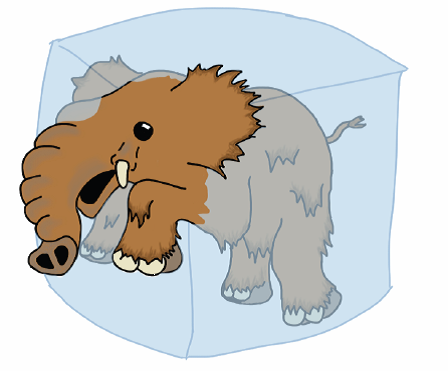How to make a Mammoth Crisp(r)

Did you see the autopsy of the incredibly well-preserved woolly mammoth last week??
I particularly enjoyed watching a group of scientists totally nerding out over a 40,000 year old frozen corpse – especially that one guy who was so darned determined to find a nice bit of mammoth poo! *Spoiler alert* – he finds some!
There wasn’t the same enthusiastic jumping-up-and-down excitement that followed the recent meteor landing, but I suppose there was more risk of a terrible mess.
During the programme, they mentioned a technique called ‘CRISPR’ (pronounced as we always aim to have our chips (or ‘fries’ to Americans) … ‘crisper‘) as a way to change or edit elephant DNA to be more similar to woolly mammoth DNA. And it’s not just mammoth cloners that are excited about this technique – the whole of genetic and molecular science is silently and carefully jumping up and down about it.
That’s because it’s pretty cool. It’s exciting because it replaces older technologies that take a lot longer, costs a lot more and are much more complicated. CRISPR can therefore potentially reduce the method of gene editing down from years to months at a fraction of the price. Although the actual practicalities of getting it to work are pretty fiddly, the general protocol is actually relatively straight forward.
So what is CRISPR?
CRISPR is not just a spelling mistake, it’s an acronym. It stands for ‘Clustered Regularly Interspaced Short Palindromic Repeats.’ Or put in simpler terms: short repeated sequences of DNA that read the same forwards and backwards, which tend to group together and have similar sized spaces between them. But ‘SRSODTRTSFABWTTGTAHSSSBT’ isn’t so pithy.
CRISPR DNA is found in bacteria and acts as their main form of defence against foreign DNA, such as from a virus. CRISPR RNA (CrRNA) locates and attaches to foreign DNA with a complementary sequence of nucleotides (see Express Yourself! for more on this). Identifying the intruder by CrRNA signals to a special enzyme, called ‘Cas9’ that can then cut (or ‘cleave’) the foreign DNA, leaving it inactive and harmless. This kind of enzyme is known as an endonuclease. The CRISPR/Cas9 system acts similarly to our immune system, in that it can remember previous infections in order to protect against future ones. The DNA sequence of an offending virus is assimilated into the CRISPR DNA so that it may be quickly identified, attacked and neutralised if it ever has the tenacity to attack again!
How is that going to bring back woolly mammoths? And why is it such a big deal?
Well, because molecular geneticists have been able to hijack this system so that it can cleave and edit the bits of DNA that they are interested in. The CRISPR/Cas9 system can be isolated from bacteria, and expressed in other cell types – such as elephant cells, or human brain cells. This means that scientists can fiddle about with different genes, and see how that changes the way cells function.
For example, imagine that a cell is expressing a gene associated with a particular disease. Stopping that gene from working – or ‘silencing’ it, may be an effective therapy or cure for that disease. To do this, scientists engineer a portion of the CRISPR DNA so that it recognises the gene they want to attack – in the same way that CRISPR would recognise previous viruses. This means that crRNA will track down the target gene, signal to Cas9 to cut it and stop it from working. Voila! The gene is silenced.
Or imagine it this way – a sniffer dog has been given the scent of a criminal they need to track down.
The scent acts as its guide to find the target, just as the DNA sequence from an interesting gene acts as a guide for the CRISPR system. The dog can then bring the criminal down, and CRISPR cuts the gene.
So how about gene editing rather than silencing? To do this, scientists hijack a different cellularfunction called ‘homologous recombination.’ Homologous recombination means that a piece of DNA that is broken can repair itself with a near-identical fragment of DNA that acts as a template. In order to edit genes, new DNA ‘templates’ are manufactured in the lab with the required edit, which are then added to the cell. That means that once CRISPR/Cas9 cuts the DNA, there will lots of near-identical templates available for cells to use to repair themselves – therefore editing their gene in the process.
If we take this back to the sniffer dog example, the homologous recombination process would be like putting a skin graft on a nasty bite the dog inflicts on the criminal – it’s not exactly the same as the original skin, but it’s close enough for a repair. Perhaps while they’re at it, the police add an electronic ankle tag so they can easily find the ‘edited’ criminal – this can also be done in cells by adding a fluorescent tag to the CRISPR/Cas9 system so it’s easy to see which cells have or haven’t been edited down a microscope.
And that’s how they might genetically engineer a mammoth! Or treat particular diseases! Or prevent inherited genetic conditions! The range of possibilities is vast, but the technology is still very much in its infancy and needs a lot of fiddling with.
However – the quick, easy and reliable editing of the human genome as a method for treating and curing disease is currently molecular genetics’ enthusiastic hunt for a woolly mammoth turd. We just need to keep on digging.
The Biocheminist
For more details about CRISPR, see:
http://www.nature.com/nbt/journal/v31/n3/full/nbt.2508.html
http://www.annualreviews.org/doi/abs/10.1146/annurev-genet-110410-132430?journalCode=genet
https://www.addgene.org/crispr/reference/history/


Recent Comments